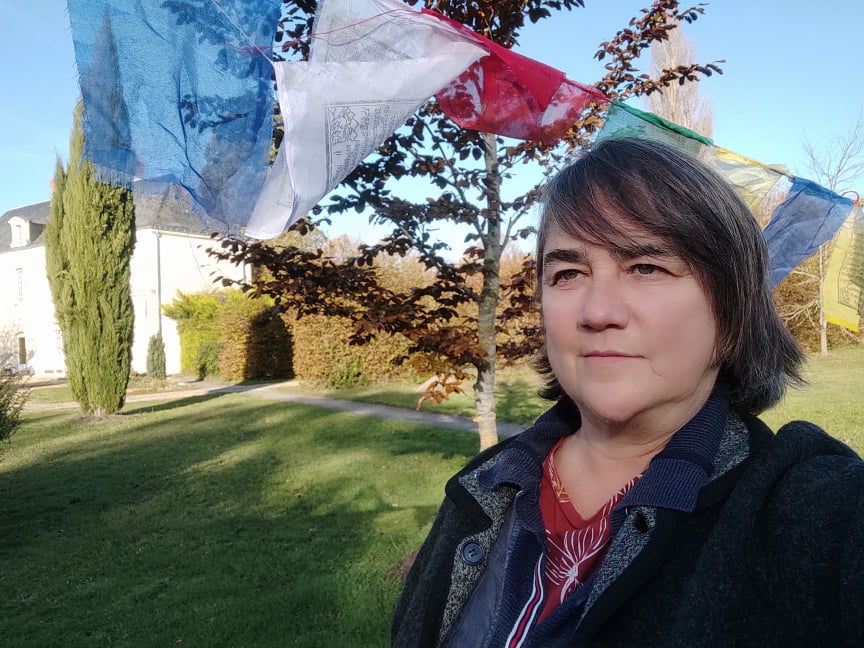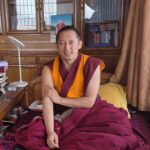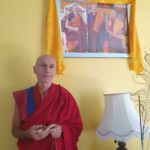Esther Pérez de Eulate from Madrid is one of the thirty participants in Shenten´s in-depth meditation program – the Gomdra. She knows what it’s like to stay for seventy days in a closed retreat and then go back to a life in a big city. “Yongdzin Rinpoche has been emphasizing the importance of integration and it is definitely a great topic for me. The Gomdra has helped me greatly to keep the Dharma alive, in my heart, even in the midst of my samsaric life,” she says.
Esther, you are one of the practitioners who attend the current Gomdra. What did you do when the 70 days of this year´s retreat ended, last November?
I left Shenten with by brother Melchi, who is also in the Gomdra, and we went to our native town where he lives. I spent some time with my family there and then I went home to Madrid. Many things, many duties, were waiting there for me. Logically, I was more or less three months out of home.
How does it feel to go back to the usual life, after such a long period of retreat?
I attended the previous Gomdra too, so I spent six seventy-day periods at Shenten before – so I have some experience of how it feels (laughs). My mood depends on whether I have a task, a project, work, waiting for me, or whether I have to invent my life on my return.
There was a year in which I was in the middle of working on a documentary and I dived back into it, with great focus. A training of the mind such as the one in the Gomdra increases the ability to focus, among other things. That transition was surprisingly easy. In other times, it is more like: “what shall I do now?”
The Gomdra and the practice in general have changed my perception of life. Sometimes I feel in conflict with my ordinary life. There is a wish to go deeper in the practice, but it is not easy to cut the bond to the samsaric world. I do not dislike the cultural life, going out with friends etc.
Anyway, I found practicing seriously and producing and directing documentaries at the same time impossible, so I decided to stop creating documentaries on my own. I have done two and I know how much work it is.
What will you do, instead?
I can participate in a project of someone else, I can do short videos, I can help my friends when they need some audio-video material. But I do not want to do things that would be overwhelming because they would weaken my practice too much.
Why did you decide to take part in the Gomdra?
I went to Shenten for the first time in 2007, it was a five-day teaching with Yongdzin Rinpoche and Khenpo Rinpoche and I remember telling myself “this is my practice”. The experience of the natural state was clear, I felt good. But when I got back home, my discipline and practice was much weaker. I know that it takes time to develop stability, I had been practicing before that with Namkhai Norbu and his community in Madrid, but still, with time, I felt that I would need to do something different to enhance my progress. I thought the Gomdra would be the opportunity for that.
You entered the second cycle of the Gomdra, starting in 2014, right?
Yes. The Gomdra was introduced at Shenten in 2009 and the second four- year cycle started in 2014. Besides me, my brother Melchiades and my sister Raquel took part. Actually, Melki made it possible for Raquel and me to be there, he was our sponsor.
Do you remember your impressions from the very beginning of the first retreat?
The beginning was hard for me. Waking up early with a cloudy mind and having to recite the morning prayers, sangcho, for half an hour of in Tibetan, day after day, was challenging. There is a lot of recitations in the Gomdra. Every day, the group performs the so called Four Generosities: sangcho, chutor, surcho, chod. It is around two hours of recitations. Besides that, at for o´clock, we accumulate mantras or recite the entreaty prayer to the lineage holders, for another hour. So, if you are not used to it (and I was not) it might be a heavy load. But I understood, from the very beginning, that it was beneficial for me, it was purifying me with strong energy and empowering me. Especially when it is integrated with the Dzogchen view.
The Gomdra was established in 2009. Each Gomdra consists of four annual 70-day long periods. Starting in September and finishing in November, around thirty participants stay in closed retreat. Currently the third cycle of Gomdra is taking place. The current cycle started in 2019 but was interrupted in 2020 due to the pandemic for one year. Between the cycles there is always a year-long break.
There is also a teaching, every day?
Yes, one hour of teaching by Khenpo Gelek. In this way we were able to integrate the teaching with the practice of Dzogchen. For each Gomdra a different Dzogchen cycle is chosen. It was Zhang-Zhung Nyen Gyud in 2014 and this time it is Yangtse Longchen, belonging to the Dzogchen cycle of Dragpa Korsum.
How did you cope with the tight schedule of the retreat?
The schedule is very tight indeed, we are busy from 6.30 to 21.30. This last time I did not miss even one session of practice, but in the past, there were days when I felt exhausted, and I skipped some. But that was exceptional. Usually I try to do them all as much as I can.
For the whole period of seventy days, nobody of the retreatants can leave Shenten. Did it sometimes feel a bit claustrophobic?
When I heard about the Gomdra for the first time, I thought that staying in a closed group for seventy days would not be possible for me. But then, I wanted so much to take this opportunity to deepen my practice that I decided that I will not think about this, I will just try.
Yes, sometimes you feel like you cannot take more. You get tense, exhausted, sad sometimes. But you just go on and on, you do your practice, and you see that your mood changes. You have time to observe your mind and you see it is changing all the time. You really experience impermanence.
There are people from different cultures in the group, with different habits and behavior, which can sometimes cause irritations. Being together can help a lot, although it also brings with it some distraction and disturbances. But Khenpo Gelek has the quality of bringing joy into the group. He is a leader who shows the way and encourages us: “go, go, go!”. And the power of the group is in the design of the Gomdra. These group retreats are organized by the monasteries for their monks too, because it helps the practice to do it together.
What about food? This must be also a sensitive topic, people from different countries have different tastes and needs…
Yes, food was a hot topic at the beginning, in the first Gomdra. Food is very important in the retreat. It is not just a matter of “I like, I do not like”. If food is not good, you do not feel good. Also, a good food makes your day much nicer. You work hard all day long and then you want to eat some tasty food. But the first year of my first Gomdra the cook used lots of canned food and additives and many people complained and asked for cleaner and fresher food. Since then, cooking has improved a lot. I would say that food is good now and people are more or less happy.
After completing the program, the participant is supposed to be ready for the 49-day long retreat in the dark. Some do, some don´t. Did you go to the dark retreat?
Yes, I went and did the whole period, which I didn’t imagine I was able to do, but you really grow and develop your practice, in the four years. You really improve a lot, and you are better equipped to maintain your practice when you are at home. I do not have many Dharma connections in Madrid and sometimes I feel like I’m living on an island. The online teaching during the whole pandemic has been really useful. After I came back from the Gomdra, there was DailyShenten and other teachings and we practiced together with the teachers and the sangha. It has been very helpful for finding some good balance between my spiritual and samsaric existence. This is the main point, the importance of integration. Yongdzin Rinpoche has been emphasizing it. I can do it better and better, keeping the Dharma alive, in the heart, even in the midst of the samsaric life.
Esther Pérez de Eulate created “A day in the Gomdra”.
You can watch it HERE.












